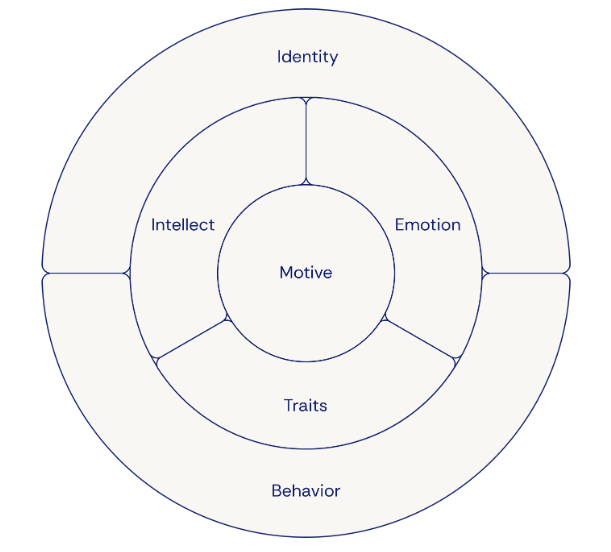
Leadership strengths can quietly turn into liabilities when they slip into overdrive — what the Blindspotting framework calls blindspots. These aren’t flaws, but strengths used without balance or awareness. The Blindspotting Self-Awareness Model, developed by Martin Dubin, PhD, maps six areas where leaders most often miss what’s holding them back: Identity, Behavior, Traits, Intellect, Emotion, and Motive. Seeing yourself clearly in these six layers helps leaders realign strengths, rebuild trust, and sustain long-term performance.
Every leader has strengths that fuel their success … decisiveness, vision, drive, care for their team. These are the qualities that get you promoted, that inspire others, that make people trust you to lead.
But what happens when those very strengths start working against you?
This is the paradox of leadership blindspots.
What once propelled you forward can quietly start to hold you back. The more successful you become, the easier it is for your greatest strengths to slip into overdrive — and the harder it is for anyone around you to tell you.
This article draws on insights from Blindspotting: How To See What's Holding You Back as a Leader, by Martin Dubin, PhD — a research-based model grounded in more than two decades of executive coaching and behavioral science. It introduces the foundation of the Blindspotting Self-Awareness Model and links to each of the six areas where blindspots most often appear.
Leadership blindspots aren’t flaws or failures. They’re patterns we don’t see clearly, often because they’re extensions of our very best qualities.
Think of it this way:
The biggest challenge is that we can’t easily see these patterns in ourselves, even when the impact is obvious to others.
[PODCAST] Listen to this podcast: Why Strengths Become Weaknesses
Every blindspot begins as a strength. It’s what happens when you lean so heavily on one strength that it overshadows others, distorts your leadership, and creates unintended consequences.
Some of the most common examples:
Blindspots don’t announce themselves. They show up as stalled projects, team dynamics that never quite click, or meetings where people leave with less energy than they arrived.
[READ MORE] How McClelland’s 3 universal motives can illuminate your blindspots

Every leader has blindspots. Some sit on the surface, easier to notice and shift. Others run deep, quietly shaping how you think, decide, and lead.
That’s why the Blindspotting model maps six areas where blindspots most often appear:
The Blindspotting Self-Awareness Model maps six areas where leadership blindspots most often appear — Identity, Behavior, Traits, Intellect, Emotion, and Motive.
Think of these as layers of awareness:
Research shows that self-awareness has a bigger impact on leadership effectiveness than even an MBA.
Self-awareness sharpens:
The higher you rise in leadership, the harder it becomes to get unfiltered feedback. People hesitate to push back. Silence can feel like agreement. Past success can convince you that your instincts are always right. Without intentional effort, blindspots grow quietly.
Self-awareness is the antidote. It’s the ability to see yourself clearly enough to spot when strengths start to tip into liabilities.
Blindspots don’t mean you’re failing. They mean you’re human. But left unchecked, they cost you, and everyone you lead.
The leaders and organizations who thrive are the ones who recognize that their strengths aren’t invincible. They invest in the awareness and accountability that keep those strengths aligned with impact.
That’s what Blindspotting Performance Coaching offers. It’s a highly personalized extension of your Blindspotting Assessment results, designed to help you turn insight into action.
This isn’t traditional coaching. It’s focused, evidence-based work that helps you refine your strengths, address blindspots, and accelerate performance, both individually and across your team.
[LEARN MORE] Explore Blindspotting Performance Coaching for individuals and teams
[BOOK A DISCOVERY CALL] See how the Performance Experience can sharpen your leadership
Think about elite athletes. The higher the level they play at, the more coaching they need, not less. Coaching isn’t a sign of weakness. It’s the key to refinement.
The same principle applies to leaders. Leadership coaching through Blindspotting Performance Coaching creates the clarity to see yourself fully. And when you see yourself clearly, everything else sharpens … your decisions, your culture, your results.
And it doesn’t stop with individuals. Leadership teams also carry collective blindspots … patterns of silence, overdrive, or avoidance that quietly shape culture. Blindspotting Coaching for Teams exposes those unseen patterns so performance can scale with alignment.
[LEARN MORE] Learn more about Blindspotting Performance Coaching for individuals and teams.
[GET STARTED] Explore Blindspotting Coaching
Leadership blindspots aren’t weaknesses — they’re strengths in overdrive. The Blindspotting Self-Awareness Model helps leaders recognize those patterns, regain balance, and lead with greater clarity.
“What we can’t see in ourselves often costs us most.” — Martin Dubin, PhD
Curious what blindspots might be limiting your own growth?
Take the Blindspotting Assessment
Explore Coaching for Emerging Leaders
Blindspotting → Identity → Behaviors→ Traits → Intellect → Emotion → Motive →









